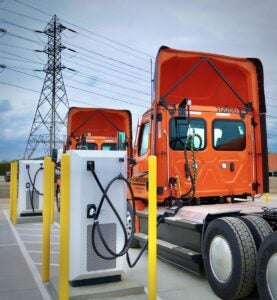Why Schneider’s deployment of 50 electric big rigs gives me hope for the future of trucking

It’s one thing to see electric trucks on the showroom floor, but it’s an entirely different feeling to see them out in the wild.
Earlier this month, I attended a ribbon-cutting event in South El Monte, California — one of the largest freight hubs in America — to celebrate the roll-out of 50 electric trucks by Schneider. While it is currently one of the largest deployments of class 8 EVs at a single depot, Schneider plans to add 42 more electric trucks to this location by end-of-year, which would have the climate impact of removing 2,400 gas-powered cars from the road.
But just a few years ago, fleets weren’t even sure it was technically feasible to electrify a depot of this size. EDF partnered with Gladstein, Neandross and Associates to analyze the capabilities of charging systems to support deployments of 40 or more trucks at a single facility. Schneider was one of two fleets that provided real-world data to support this analysis. The study found that not only are current and emerging electric truck models and charging systems capable of meeting most of the technical needs of the fleet studied, they offer operational and fuel alternatives over diesel tractors.
This deployment is a real milestone for America’s biggest trucks on their road to electrification. It proves that even though scaling electric trucks is a challenge, it’s doable and there are ways fleets can learn from existing projects to help navigate the process.
Why Schneider’s deployment of 50 electric big rigs gives me hope for the future of trucking Share on XAs I walked the surprisingly tranquil charging depot, there were three things that struck me as key elements of Schneider’s success:
The project team was critical to the success of this deployment
A key step in electrifying a fleet is putting together a strong project team that brings together diverse expertise and fosters collaboration across all aspects of a company. At the ribbon-cutting, I met with project team members- ranging from executives, engineers, team leads, drivers and technicians — all proud to share their contributions to the project and excited about what is to come.
For many fleets, transitioning to electric vehicles will require additional subject matter expertise. Fleet managers embarking on this journey can benefit from bringing in team members versed in infrastructure and construction management, charging station optimization and management, and EV service and maintenance.
In addition to those valuable team members, drivers will be key players in ensuring the successful roll-out of electric trucks. Fleet managers have stressed the importance of drivers when introducing electric vehicles to their fleets. This was also very much the case at the Schneider launch, where experienced drivers were the heroes of the day, responsible for driving fuel savings, extending vehicle range and even minimizing tire ware.
Electrify the vehicles you can today, but plan for tomorrow
One of the key actions to a scaled electric truck deployment is doing your homework.
Analyzing routes, loads and other operational details — like driver shifts and charging times — is the next step fleets should take to turn initial analyses into real trucks, running real routes. For this deployment, Schneider identified ways electric trucks would both meet their operational requirements.
One notable way Schneider is doing this is by taking advantage of slip-seating — where multiple truck drivers share a set of trucks during different shifts. Here, a set of trucks will remain at the depot to charge while drivers run their routes. When they return to the depot for their break or shift change, they can leave that vehicle to charge, and a freshly-charged truck will be ready for them. This allowed Schneider to take advantage of managed charging benefits- like reduced peak load and responding to the needs of the grid and furthering the total-cost-of-ownership benefits of electric over diesel.
Smart policies and partnerships enable bold action
Schneider did not accomplish this on their own. External partners including state and local agencies, utilities, construction management and manufacturers were all critical partners in getting these 50-trucks on the road. The Joint Electric Truck Scaling Initiative facilitated the effort to coordinate these stakeholders. Smart policies like JETSI will help ensure 100% of all new trucks are zero-emission by 2035 — a target we must hit to address the serious climate, health and equity crises we face.
As someone who grew up just a stone’s throw away from where this depot is located, it’s personally exciting for me to see these clean trucks readying to drive the freeways that encircle my hometown community. Transportation is the fastest-growing source of climate emissions and a major source of deadly air pollution — especially in disadvantaged communities. Trucks are a leading culprit of this dirty pollution. Growing up next to these densely trafficked corridors have shown me real consequences for human lives and community health, which is why it’s so important to see these vehicles transitioning to zero-emission alternatives.
While this deployment is an exciting step toward reducing emissions from some of the heaviest polluting vehicles on the roads, we still have a lot of work to do. No single organization, agency, company or sector can do this on their own.
For fleets interested in taking the next step in electrification, EDF developed the Fleet Electrification Solution Center, a free guide for fleets to follow along a step-by-step electrification journey to replicate the successes and best practices of fleets like Schneider.










